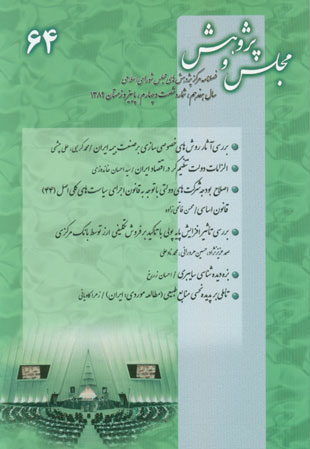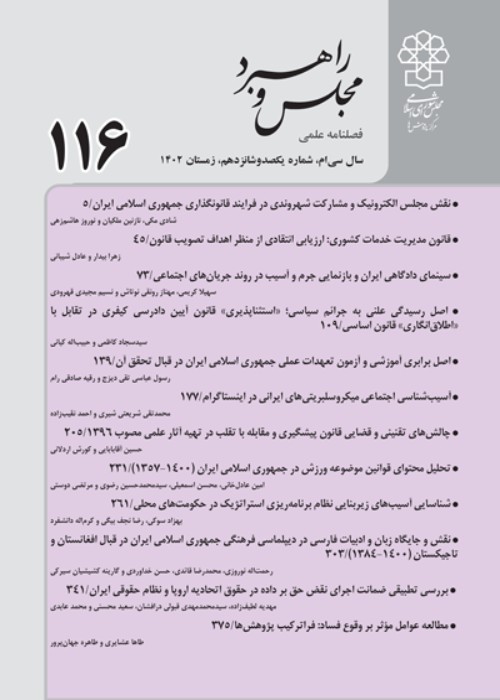فهرست مطالب

فصلنامه مجلس و راهبرد
پیاپی 64 (پاییز و زمستان 1389)
- 204 صفحه، بهای روی جلد: 15,000ريال
- تاریخ انتشار: 1390/08/25
- تعداد عناوین: 7
-
صفحه 5
-
صفحه 127
-
Page 7Countries resorted to the privatization to solve the problem of stateowned enterprises inefficiency. There are two serious methods of the privatization: Chinese and Russians. In China that called "privatization from below", markets are open for private enterprises but in Russia,privatization performed by state ownership transfer. The privatization program in Iran insurance industry initiated from 2000 and performed through privatization from below, but has proceeded by ownership transfer of public insurance companies since 2009 according to the Implementation of General Policies of Article (44) Act of the Constitution.The paper shows that privatization from below in competition extension in insurance industry has had more effects on Iran insurance industry by extending insurance industry practices, leading to differentiation in insurance industry products, even improving performance indices of public insurance companies by creating competition. While transfer of state-owned insurance enterprises (although it is still early) has led that only state-owned insurance enterprises are changed into nongovernmental insurance enterprises apparently by quasi-governmental organizations, state management has been continued and the privatization hasnt had significant effect on their efficiency yet. So it is proposed to complete the privatization program in the insurance industry that subsequent measures should be put on the agenda: insurance enterprises ownership should be transferred in order to extend competition and increase their efficiency, liberalization and deregulation in insurance industry should be continued in its institutional regulation reform framework to have more effects of the privatization from below, in order to the equalization of insurance enterprises business like private insurance enterprises, establish serious budget constraints on public insurance companies and extend the relevant markets to the insurance industry.Keywords: Privatization Methods, Competition, Structure, conduct, Performance, Insurance Industry, Public Insurance Enterprise
-
Page 41Notification of general policies of Article (44) of the constitution is a turning point in Iranian approach to the concept of state and market.Changing the attitude of government-centered to market-oriented economic growth and being transparent of entry borders and market action are the main achievements of these policies. But it will be not only the end of state-market problem, but also is starting point of some new issues in Iran's economy that scientific accuracy was less needed ever. Among these emerging issues, there are government actions about the targets and its controls on the (regulation) market.Definitely, in the market-oriented environment, methods and tools of government intervention in the economy should be different from traditional methods (such as direct policies, or monetary-financialcommercial policies). With such an attitude, regulation has been regarded as an instrumental attitude by economists for decades.The paper attempts to review the theories of regulation objectives,regulatory body (or regulator) and regulation rights and present the list of successful strategies, in terms of the current conomic conditions of Iran.Keywords: Regulation, Public Sector, Iranian Economy, Private Sector, General Policies of Article (44)
-
Page 81There is computational uncertainty and information gap in the current method of the state-owned companie's budget which reflects in the total budget of the country. Wide variety of state-owned companies, the complexity of the budget figures, the uncertainty of budget estimates are the source of these problems. Under these conditions,focusing on indicators of budget figures of state-owned companies can not provide useful information to evaluate the performance of these companies and even causes to deviate regulatory agencies. Also the current state of the insertion of state-owned companies doesnt help to enforce the implementation of General Policies of rticle (44) Act as the main law for the situation of state-owned companies at all. Thus,two proposals are considered to adapt state-owned companie's situation to General Policies of Article (44) Act as well as more suitable information packages to be created to evaluate the performance of these companies: First, omitting the clause of at least 50 percent of the government shares for the investment of a company in the government budget that in this case, the amount of the state's stock and capital are reflected in the budget; as a result of it, information gap in the main part of the state capitals in companies that less 50 percent of their capitals belong to the state is removed. Second, reform of state-owned companie's classification so that they are consistentwith three groups of General Policies of Article (44) Act. In completing this classification, companies of each group are separated into subgroups according to ISIS codes and efficiency and effectiveness of these companies can be measured by using combined information ofeach subgroup and also specific indicators in accordance with its missions.Keywords: Budget, State, owned Companies, Article (44) of the Constitution
-
Page 101Monetary base is one of the variables that could affect liquidity and inflation. With regard to the compulsory sale of foreign currency (ceiling and the amount of foreign currency) by Iranian Central Bank is one of things that can affect the monetary base in different circumstances, the paper studies the effect of increasing the monetary base, with emphasis on compulsory sale of foreign currency by the Central Bank. The study is descriptive. Results of the study reflect the fact that from 2000 onwards, the government has provided budget deficit and foreign currency resources through the exchange of Treasury and Foreign Exchange Reserve Account, and receiving the equivalent value of the Rial instead of direct borrowing from the Central Bank that due to the market stagnation, a percent of foreign exchange hasnt been sold and deposited in the Central Bank portfolio and increased the monetary base and liquidity growth which has somewhat affected on the inflation rate in the years studied.Keywords: Compulsion, Currency (Exchange), Monetary Base, Liquidity, The Government, Central Bank
-
Page 127Victimology or the study of crime victims has been suggested by criminologists for decades and many have written about his/her identification and explanation of his/her role in committing a crime,the outline of cyber-crime victimization fields and ways to support victims. Meanwhile, discussion about victims of cyber crimes that has been long added to the legal literature is very important so that knowing them as victims of new generation of crimes is so significant.Thus, some foreign authors on the basis of Lifestyle-Routine Activities Theory and Learning Theory have explained the cybercrime victimization that accordingly in this paper, cyber-crime victimization were surveyed and it was found that cyber crime victims are divided into two general categories: they have had a direct role in their crime victimization or they have prepared the way for their own crime victimization indirectly and there are a few victims who are not in these two categories. The analysis of cyber-crime victimization is based on three factors: the offender was provoked, appropriate target,and lack of capable protective force that have utilized these factors to explain cyber victimization in this paper and concluded that external and situational factors have major roles in committing cyber crime victims.Keywords: Victimology, Cyber Space, Real Space, Computer, Lifestyle, Routine Activities (Theory)
-
Page 159Resources Curse term has begun to emerge in the economic literature since 1995. Summarily, the term refers to failure of countries with an abundance of natural resources to achieve remarkable economic growth and their institutional inefficiency. Before Resource Curse theories in the economic literature, natural source was economic growth factor in many countries including the United States. But over time and the advent of revealed events of oil countries performance and low or negative economic growth achieved in these countries,economists determined to explain this phenomenon and its causes. In this regard, theories such as Dutch Disease, interaction with the quality of institutions, natural resources in the economy, rent-seeking,corruption, and … are such cases that try to explain the poor performance of countries with natural resources.The paper explains "Resource Curse" term and surveys the causes of these failures in countries with natural resources, especially oil countries and will answer to this question that why the natural source of oil hasnt contributed to the improvement of macroeconomic variables in a country as well as it has prepared a way for poor performance of countries with natural resources. Accordingly, Iran as a source of oil will be studied.Results of the study show that the per capita income growth in Iranian economy has been greatly affected by the phenomenon of resource curse. So that the per capita income growth during the oil sock of 1977-1980 has been declining and negative inputs. Some studies suggest that Dutch disease has occurred in Iranian economy.Employment data in different sectors show that during the1996-2006 decade, employment in the tradable sector of Iranian economy has been reduced, but non-tradable sector has been increased. Also, in this study, there is the evidence for emerging other theories explainingresource curse in Iranian economy.Keywords: Oil Economy, Resource Curse, Dutch Disease, Rent, seeking


